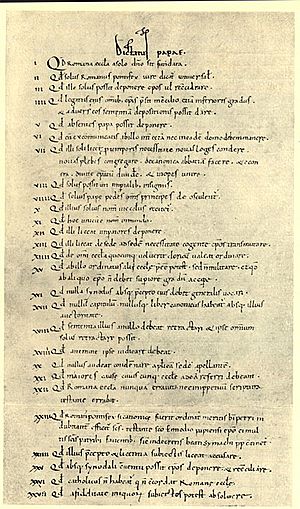Dictatus papae facts for kids
The Dictatus Papae is a special list of 27 statements about the power of the pope. It was written down around the year 1075, during the time of Pope Gregory VII. Think of it like a declaration of what the pope believed his role and authority should be.
What is the Dictatus Papae?
The ideas in the Dictatus Papae mostly come from something called the Gregorian Reform. This was a big movement to make the Church stronger and more independent. The Dictatus Papae makes very strong claims about the pope's power. It says the pope is the highest authority (this is called papal supremacy). It also suggests the pope cannot be wrong in matters of faith (this is called infallibility).
One of the most important statements says the pope can even remove emperors from power. This was a huge claim! Before this, there was a balance between the spiritual power of the Church and the worldly power of kings and emperors. The Dictatus Papae said the pope's spiritual power was above the emperor's worldly power.
Later, another pope, Pope Boniface VIII, used a similar idea. He talked about "two swords" in a document called Unam Sanctam. One sword was for spiritual power (held by the pope). The other was for worldly power (held by kings). But the pope's sword was seen as the more important one.
The Dictatus Papae also had some interesting rules. For example, statement 9 says, "All princes shall kiss the feet of the Pope alone." Statement 10 says, "His [the pope's] name alone shall be spoken in the churches." These show how much respect and power the pope expected.
Who Wrote the Dictatus Papae?
The name Dictatus Papae means "papal dictation." It suggests that the pope himself wrote or dictated these statements. It wasn't something that was widely shared or published at the time. It was mainly kept within the pope's close circle.
Historians still debate who exactly wrote it. Some believe Pope Gregory VII wrote it himself. Others think it might have been written by someone else and added to his records later.
Around 1087, a cardinal named Deusdedit, who was a friend of Gregory, put together a collection of Church laws. This collection is called canon law. The ideas in the Dictatus Papae are very similar to what Deusdedit collected. This makes some historians think the Dictatus might have been based on Deusdedit's work.
Key Ideas from the Dictatus Papae
Even though there are 27 statements, they all point to the pope having immense power. Here are some of the main ideas:
- The Roman Church was founded by God alone.
- Only the Roman pope can be called "universal."
- Only the pope can remove or bring back bishops.
- The pope's representative (legate) has authority over all bishops.
- The pope can make new laws and organize new groups of people for the Church.
- Only the pope can use the special symbols of an emperor.
- All rulers must show respect to the pope.
- Only the pope's name should be mentioned in churches.
- The pope can remove emperors from power.
- The pope can move bishops from one place to another if needed.
- The pope can ordain (make) clerics (church officials) from any church.
- No major Church meeting (synod) can be called without the pope's order.
- No Church law or book is valid without the pope's approval.
- No one can change the pope's decision, but the pope can change anyone else's.
- No one can judge the pope.
- Important cases from any church must go to the pope.
- The Roman Church has never made a mistake and never will, according to scripture.
- A pope, if properly chosen, becomes holy because of Blessed Peter.
- The pope can allow subjects to accuse their leaders.
- The pope can remove or bring back bishops without a big meeting.
- Anyone who doesn't agree with the Roman Church is not considered a true Catholic.
- The pope can release people from their loyalty to unfair rulers.


